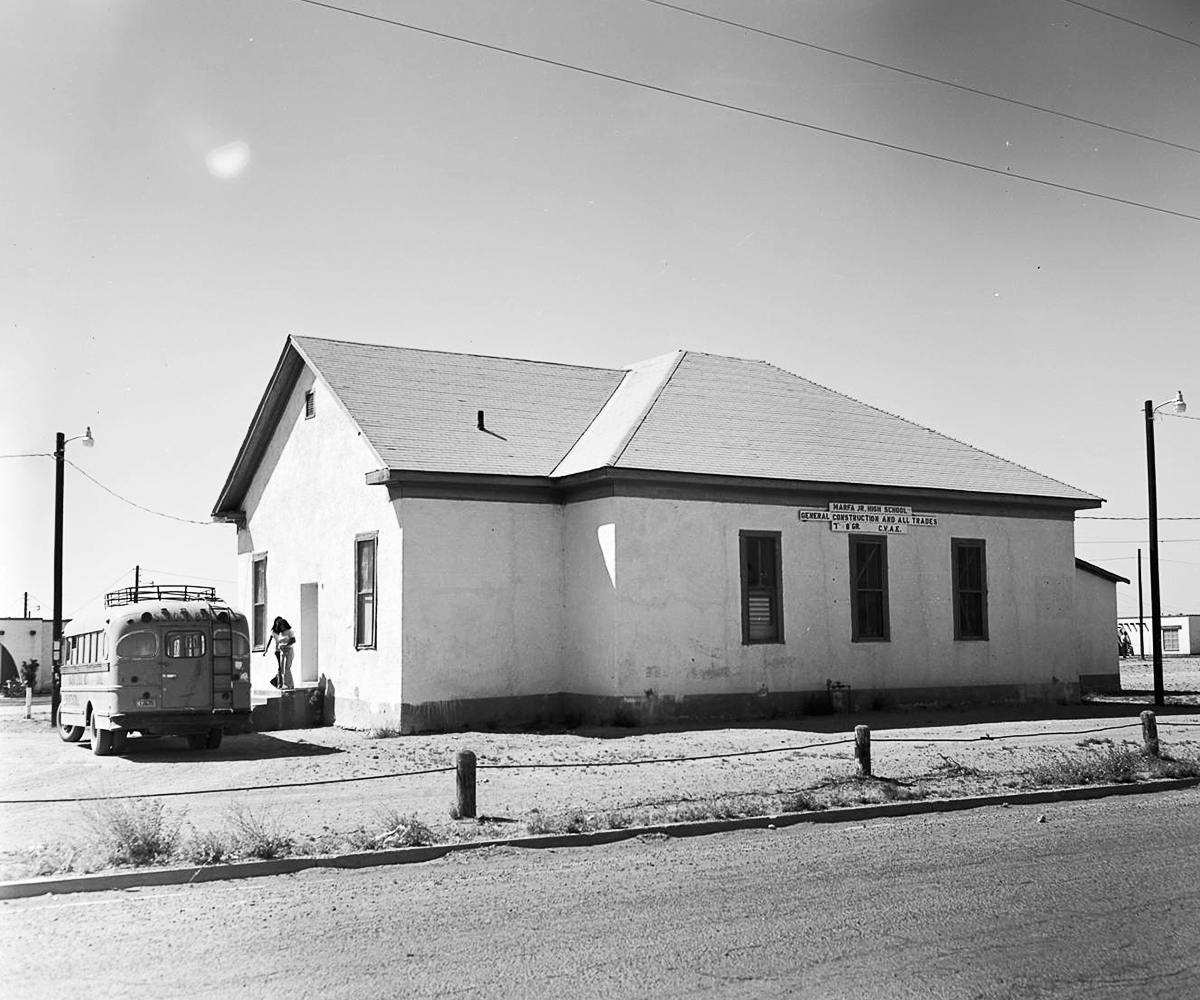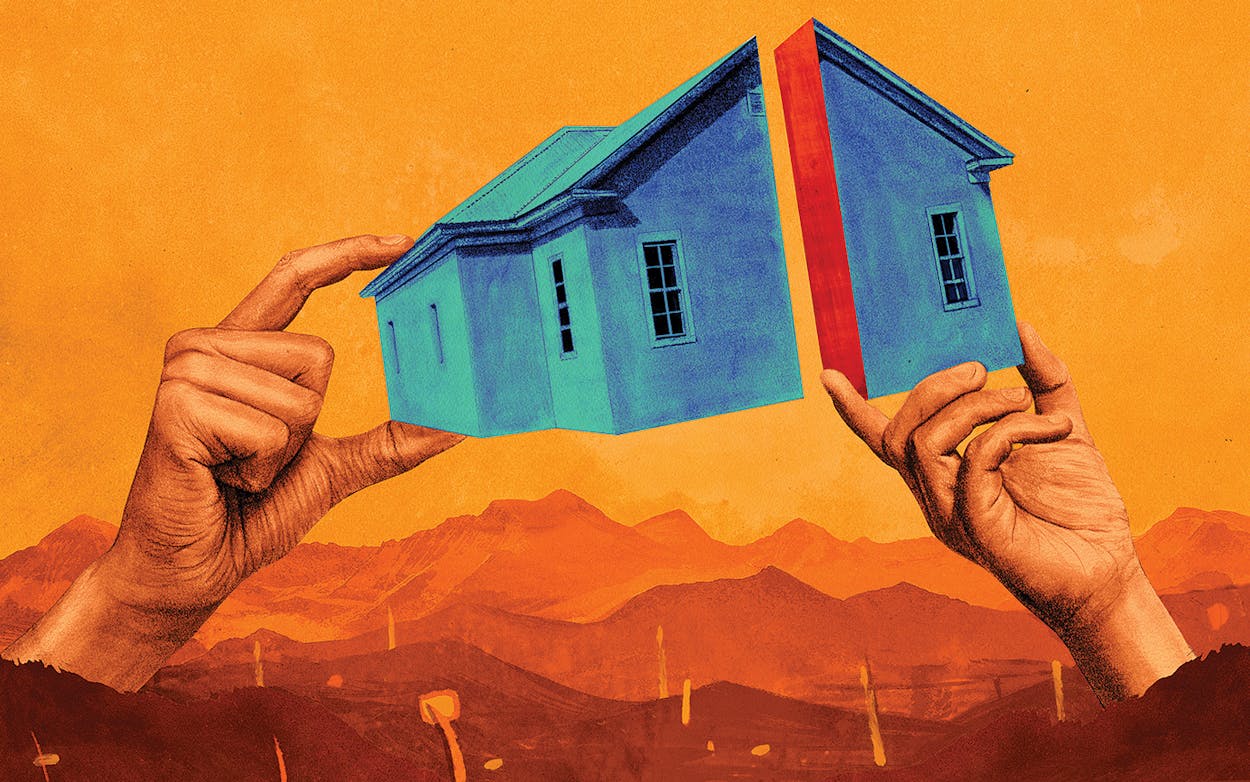The Blackwell School sits alone on a block on Marfa’s south side, surrounded by modest adobe homes, an orderly sprawl of public housing apartments, and the Border Patrol’s sector headquarters. The school building is unadorned and looks pleasingly like it might’ve been a church. Inside, an adobe wall divides the space into two long, airy classrooms. Blackwell’s colors are red and black. Its mascot: the Broncos.
Blackwell was Marfa’s segregated school for Mexican American children until integration was achieved in 1965. While law mandated separate schools for African Americans during the Jim Crow era, it was up to individual districts to decide whether to segregate Hispanics. Many of them did. By the forties, more than 120 towns across Texas had stipulated segregated schools for Hispanics, including several in the Big Bend. Marathon built the Hidalgo Ward School in 1910; in 1936 Alpine built its segregated facility and named it Centennial School, apparently without irony, to honor the one hundredth anniversary of Texas’s independence from Mexico.
Marfa’s segregated campus, eventually named for Jesse Blackwell, a teacher and principal, included first through eighth grades and, for a time, ninth grade. Thousands of students were educated there over the decades. At its peak enrollment, in the late forties, about six hundred students attended, and half a dozen buildings dotted the grounds. The school was known for its terrific marching band and a good football team. “Blackwell Wins First 6-Man Game Against Marathon,” the Big Bend Sentinel reported in September 1950, further noting the team had “plenty of scrap.” A vibrant PTA led meetings in Spanish and English and held carnivals to raise money for instruments, uniforms, and school supplies. “We had everything we needed because of them,” remembered Maggie Marquez, who was at Blackwell in the fifties. “Our band uniforms were just beautiful. Our parents made sure we were well educated. We had a lot of pride in Blackwell.”
Those who wanted education after Blackwell attended Marfa High School with their Anglo counterparts. The prevailing thought, evidently, was that high school was beyond the abilities or desire of most Hispanic kids. “It was assumed no Mexican-American children would continue . . . ” wrote local historian Lonn Taylor, “even though a young man named Juan de la Cruz Machuca became the first Hispanic to graduate from Marfa High School in 1911.” By the sixties, he added, most Blackwell students did continue to high school, where, in fact, they bloomed. “The people in charge thought we’d go into the service or work instead of staying in school,” said 82-year-old Lionel Salgado, who attended Blackwell in the forties before going on to Marfa High School. “Our teachers were really good and kind, and a lot of those kids were bright kids. They’d get up to Marfa High School and be valedictorian or salutatorian. We carried ourselves pretty good.”
Despite the students’ successes and the thread of Blackwell boosterism that helped bind Marfa’s Mexican American community, this was a trying time. Blackwell students, and Mexican Americans in general, suffered various indignities. “Marfa is where I learned about racism,” said Jesusita Williams Silva, who started first grade at Blackwell in 1956. “Seeing my mother pushed away at a store because she was Hispanic. Seeing my father work and not get paid enough because he was Hispanic. Seeing people humiliate my parents in front of their children.” Silva’s eyes grew glassy with tears. “All that hurt. It still hurts.”
Marquez was in fourth grade when her teacher one day instructed everyone to write down, “I will not speak Spanish in school or on the playground.” The teacher gathered the notes and put them in a cigar box. The children assembled outside, and then the cigar box was lowered into a hole dug at the base of the flagpole and buried. “They wanted us to speak English only,” said Marquez. “I told my friends, ‘Nadie me va quitar que hable el español.’ No one will take Spanish from me. A teacher heard me, walked me to the office, and I got whupped hard with a big paddle. I ran home and didn’t go back until my dad made me. I was black-and-blue.”
Silva also remembers the scene around the flagpole. “You know what happened from that? I developed a habit of staying low. Don’t speak out, don’t speak up. I was intimidated.”
There are other stories—of one student being forced to bathe another who was assumed to be dirty because of her dark complexion; or of the Blackwell boys in the fifties, who were good enough to play on a combined football team with the Anglos but not allowed to use the locker room.
Even though high school was integrated, the separation didn’t end there. During meetings in the auditorium, Anglos were instructed to sit on one side and Hispanics on the other. The Palace movie theater downtown was similarly segregated. And you’d better have been on the right side of the tracks or inside after dark. Marquez, who played high school basketball with Anglo and Hispanic girls, remembers one evening, after a game in Alpine, when the coach stopped for burgers at a cafe. “The sign on the door said, ‘No Dogs, No Mexicans,’ ” she recalled. “I said, ‘Watch and see.’ ” Marquez, who is light complected, slid between her Anglo teammates, entered the cafe and ordered for her friends, then ran out to the bus with the food, to the whoops of the team. “I did it. I showed them.”

Blackwell closed in January 1965, joining a number of segregated schools across Texas and elsewhere that shut down in the wake of the Supreme Court’s Brown v. Board of Education decision and, in many cases, federal intervention. In Marfa, integration came with the opening of a new, windowless elementary school. “[The building], under construction for several months, was occupied this week by students of both the old Marfa Elementary and Blackwell Elementary schools,” the Sentinel reported matter-of-factly. Neither the paper’s accompanying history piece about the town’s schools nor its biography of Mr. Blackwell mentioned why two elementary schools had existed for all those years. Most of Blackwell’s official records have been lost to time. One detail about integration is remembered by those who lived it: on the day students made the move from Blackwell, they were told to pick up their chairs and desks, and they walked the furniture to their new campus, about a mile away.
Former Blackwell students are now in their sixties or seventies or beyond, and many of them still live in town. Salgado noted that a number of former students became teachers, including his brother, who rose to become the principal of an Austin high school. Others turned to law careers or work in health care. Many served in the military, raised families, volunteered. Some, like Salgado, who held spots on the school board and city council, ran for elected office and won, gradually turning Marfa’s political landscape into a reflection of the community’s majority Hispanic population. “It was all Anglos in office back then,” Salgado said. “We said to each other, ‘We’ve got to do something about this.’ And we did.”
Blackwell’s buildings languished. Most were razed years ago to build public housing on the site, some of which is populated by the children and grandchildren of the formerly segregated students. Only the church-like building was left and the small band hall attached to it. The school district owned the building and used it as deep storage. In 2006, as the district discussed its possible demolition, a group of alumni calling themselves the Blackwell School Alliance came up with a plan that was universally well received: turn the former segregated school into a welcoming community hub. They secured a 99-year lease on the building and filled its walls with mementos, photos, and informational placards. A historical marker was erected outside; an adjacent park was created. Reunions were held, including the 2007 event at which the crowd, standing near the site of the old flagpole, cheered as Maggie Marquez pulled a Spanish dictionary from a small plywood coffin that had been buried for the ceremony. “¡Yo tengo el español!” she cried out, holding it aloft.
Grant applications are in the works for much-needed renovations to the building’s drafty windows, a problem adobe wall, the old beadboard ceilings, and the creaky floors. This past April a mural featuring Blackwell was unveiled downtown, and the Alliance established an annual party at the old campus, with music, food, lotería, and a ton of laughter and reminiscing among neighbors. “We had 250 people show up,” said Salgado, a strong showing, he noted, in a town of 1,800 residents. “We had so many volunteers that the Alliance members hardly had to lift a hand.”
What was once a school that represented separation is a place that now joyfully embraces inclusion. Gretel Enck is the Alliance’s volunteer president, and she opens the building to visitors every Saturday. “Blackwell is not just a monument to Marfa’s racist past,” she said, “though there are lessons to be learned from that and experiences to be honored and heard. But we also hold Blackwell as a center for Hispanic life in Marfa. We want to tell the bigger story of Hispanics in Marfa and serve as a community center and a space that honors that history.”
The graceful building itself is central to their mission. “If they’d torn down the building,” said Salgado, “our history would’ve disappeared. We’re holding on to that little piece of history. This happened. It’s part of Marfa.”

First Blood
In 1930, long before the Brown v. Board of Education decision, Jesús Salvatierra and a group of fellow parents sued Del Rio ISD, claiming that children of Mexican descent did not receive the same educational benefits as white children.
Not quite 360 students attend Marfa’s schools today; 86 percent of them are Hispanic and three quarters are considered economically disadvantaged. One of the Alliance’s goals is to create a curriculum that teaches them about how school was different in Blackwell’s time, in the days of their grandparents and great-grandparents.
Things seem better now, mostly. My view on race relations comes from the perspective of a 51-year-old Anglo woman, so take that for what it’s worth. But looking around Marfa during a volleyball game, when we are all sweaty fisted and clad in Shorthorn purple, or sitting at the burrito joint during the lunch rush, jammed elbow to elbow, it’s hard to reconcile those old, terrible stories with the sweetness and ease with which people appear to conduct themselves today.
As Salgado said, though, it happened. How does someone transcend the wrongs done to them? How does someone not concede to bitterness? Forgiveness takes deliberate effort, said Silva. Recently, a man who’d been ugly to her in childhood made a subtle gesture of apology, which she accepted. “There are good and bad people in every culture. You’ve got to let racism go. I try to accept the person in front of me. There’s good in everybody.”
From his seat at a booth at Dairy Queen, Salgado shook hands with or waved at nearly everyone who came through the door. “You treat people the way you want to be treated,” he said. “It pays off. I don’t have resentment. When I look out, I don’t see Anglo or Hispanic. I see nothing but Marfans. I see only Marfa.”
This article originally appeared in the January 2019 issue of Texas Monthly with the headline “The Old School.” Subscribe today.
- More About:
- Texas History
- Marfa








